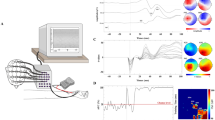Abstract
Evoked potential monitoring is a standard examination method in neurological intensive therapy units. Previously, multimodality observation was only possible in follow-up examinations. First experience with a new bed-side system continuously monitoring 12 neurophysiological and clinical parameters is reported. It consists of a personal computer and various stimulation units. EEG activity, median nerve somatosensory evoked potentials (SEPs) and brainstem auditory evoked potentials (BAEPs) are recorded. Additionally, EEG spectral band power, heart rate, heart rate variability, intracranial presure, body temperature, expiratory PCO2, blood pressure and transcutaneously measured oxygenation can be monitored. This paper reports on 4 exemplary cases of the 33 patients we have monitored to date, illustrating the principles and main advantages of the system. The system was developed to support the observation of ICU patients as well as to aid therapeutic decisions. It supports the clinical determination of brain death by specifying the deterioration of various neurological systems.
Similar content being viewed by others
References
Pampiglione G, Waterston DJ (1958) Preliminary EEG observations during partial and complete occlusion of cerebral blood flow. Electroenceph Clin Neurophysiol 10:354 P
Faulconer A Jr, Bickford RG (1960) Electroencephalography in anesthesiology. Thomas, Springfield II.
Bickford RG, Billinger TW, Fleming NI, Stewart L (1972) The compressed spectral array (CSA) — a pictorial EEG. Proc San Diego Biomed Symp 11:365–370
Bricolo A, Turazzi S, Faccioli F, Odorizzi F, Sciarretta G, Erculiani P (1978) Clinical application of compressed spectral array in long-term EEG monitoring of comatose patients. Electroenceph Clin Neurophysiol 45:211–225
Prior PF, Maynard DE (1986) Monitoring cerebral function. Long-term monitoring of EEG and evoked potentials. Elsevier, Amsterdam New York Oxford
Sulg IA, Sotaniemi KA, Tolonen U, Hokkanen E (1981) Dependence between cerebral metabolism and blood flow as reflected in quantitative EEG. A clinical review. Adv Biol Psychiatry 6:102–108
Hashimoto I, Ishiyama Y, Totsuke G, Mizitani H (1980) Monitoring brainstem function during posterior fossa surgery with brainstem auditory evoked potentials. In: Barber C (ed) Evoked potentials. University Park Press, Baltimore, pp 377–390
Grundy BL, Jannetta PJ, Procopio PT, Lina A, Boston JR, Doyle E (1982) Intraoperative monitoring of brainstem auditory evoked potentials. J Neurosurg 57:674–681
Raudzens PA (1982) Intraoperative monitoring of evoked potentials. Ann NY Acad Sci 388:308–326
Garcia-Larrea L, Bertrand O, Artru F, Pernier J, Mauguière F (1987) Brain-stem monitoring. II. Preterminal BAEP changes observed until brain death in deeply comatose patients. Electroenceph Clin Neurophysiol 68:446–457
Symon L, Wang AD, Costa de Silva I, Gentili F (1984) Perioperative use of somatosensory evoked responses in aneurysm surgery. J Neurosurg 60:269–275
Mauguière F, Brunon AM, Echallier JF, Courjon J (1982) Early somatosensory evoked potentials in thalamo-cortical lesions of the lemniscal pathways in humans. In: Courjon J, Mauguière F, Revol M (eds) Advances in neurology, vol 32: Clinical applications of evoked potentials in neurology. Raven Press, New York, pp 321–338
Noel P, Desmedt JE (1975) Somatosensory cerebral evoked potentials after vascular lesions of the brain-stern and diencephalon. Brain 98:113–128
Buchner H, Ferbert A, Hacke W (1988) Serial recording of median nerve stimulated subcortical somatosensory evoked potentials (SEPs) in developing brain death. Electroenceph Clin Neurophysiol 69:14–23
Maresch H, Gonzalez A, Pfurtscheller G (1985) Intraoperative patient monitoring including EEG and evoked potentials. In: Proceedings of XIV ICMBE and VII ICMP, Espoo, Finland, pp 776–777
Pfurtscheller G, Schwarz G, Schroettner O, Litscher G, Maresch H, Auer L, List W (1987) Continuous and simultaneous monitoring of EEG spectra and brainstem auditory and somatosensory evoked potentials in the intensive care unit and the operating room. J Clin Neurophysiol 4:389–396
Litscher G, Schwarz G, Schalk HV, Pfurtscheller G (1988) Polygraphisches Neuromonitoring nach Medikamenlenintoxikation. Intensivbehandlung 13:154–158
Litscher G, Friehs G, Maresch H, Pfurtscheller G (1990) Electroencephalographic and evoked potential monitoring in the hyperbaric environment. J Clin Monit 6:10–17
Maresch H, Pfurtscheller G, Schuy S (1983) Brain function monitoring: a new method for simultaneous recording and processing of EEG power spectra and brainstem potentials (BAEP). Biomed Tech 28:117–122
Steller E, Litscher G, Maresch H, Pfurtscheller G (1990) Multivariables Langzeitmonitoring von zerebralen und kardiovaskulären Größen mit Hilfe eines Personal-Computers. Biomed Tech 35:90–97
Litscher G, Pfurtscheller G, Schwarz G, List W (1987) Akustisch evozierte Hirnstammpotentiale-Voraussetzung für klinische Anwendung, Datenqualität und Fehlerquellen. Anaesthesist 36:555–560
Nuwer MR (1986) Evoked potential monitoring in the operating room. Raven Press, New York
Ferbert A, Riffel B, Buchner H, Ullrich A, Stöhr M (1985) Evozierte Potentiale in der neurologischen Intensivmedizin-eine Standortbestimmung. Aktuel Neurol 12:193–198
Hacke W (1985) Neuromonitoring. J Neurol 232:125–133
Haupt FW (1988) Evozierte Potentiale bei Hirnstammprozessen. Thieme, Stuttgart
Greenberg RP, Newlon PG, Hyatt MS, Narayan RK, Becker DP (1981) Prognostic implications of early multimodality evoked potentials in severly head injured patients. J Neurosurg 55:227–236
Druschky KF, Pfurtscheller G, Hilz MJ, Wack P, Neundörfer B, Litscher G, Brinkmann HG (1989) Multimodale elektrophysiologische Komaskala (MECS) als prognostisches Kriterium bei Hirnstammprozessen. In: Bogdahn U, Mertens HG (eds) Prognostik in der Intensivtherapie des Zentralnervensystems. Springer, Heidelberg New York, pp 290–296
Bertrand O, Garcia-Larrea L, Artru F, Mauguière F, Pernier J (1987) Brain-stem monitoring. I. A system for high-rate sequential BAEP recording and feature extraction. Electroenceph Clin Neurophysiol 68:433–445
Author information
Authors and Affiliations
Additional information
Supported by the “Fonds zur Förderung der wissenschaftlichen Forschung”, project S49/03 and the Ministry of Science and Research, Austria
Rights and permissions
About this article
Cite this article
Hilz, M.J., Litscher, G., Weis, M. et al. Continuous multivariable monitoring in neurological intensive care patients-preliminary reports on four cases. Intensive Care Med 17, 87–93 (1991). https://doi.org/10.1007/BF01691429
Received:
Accepted:
Issue Date:
DOI: https://doi.org/10.1007/BF01691429




